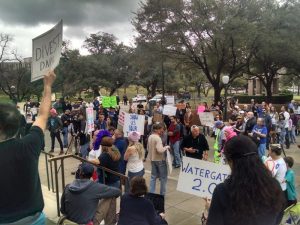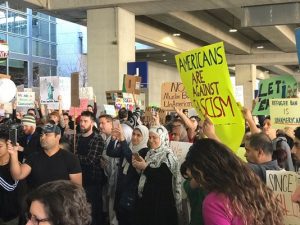by Carmen Gutierrez
Inspired to contribute to our sociological understanding of the Black Lives Matter movement and of racial angst in the U.S., Dr. Rashawn Ray, Associate Professor of Sociology at the University of Maryland at College Park, began investigating police killings, the social psychological dimensions of why police kill Black males with impunity, and the collective action responses to these events.
Dr. Ray recently shared some of this work in an invited lecture sponsored by the Population Research Center at the University of Texas at Austin. Dr. Ray’s presentation provided a glimpse of his current research on a variety of timely, important social issues, summarized in the title, “Police Compliance, Body Cams, and Black Lives: Racial Bias in the Criminal Justice System.”
Dr. Ray and his work motivates us to continue working toward an equal society where all people experience fairness and justice. We believe Dr. Ray’s research makes a necessary contribution to the current social and political climate as a growing number of Black men and women suffer the harmful consequences of discriminatory policing. As we recently passed the day marking the fifth year when the world learned of the life and death of Trayvon Martin, we write this review in his honor and in celebration of the wonderful work of Dr. Ray.
Here are 10 points inspired by Dr. Ray’s recent presentation:
- PEOPLE OF COLOR HAVE WORSE EXPERIENCE WITH THE POLICE
Dr. Ray explained that people of color have long suffered from disproportionate surveillance and violence from the police. According to a recent study using data on the “stop-and-frisk” practices by the NYPD, Blacks and Latinos are stopped by the police 23% and 39% more often than Whites. More specifically, when police officers suspect individuals of violent crimes and weapons offenses—the most common suspected charges, representing more than two-thirds of stops by police—Blacks and Latinos are stopped by the police twice as often as Whites.[i]
- DISPROPORTIONATE POLICING OF MINORITIES IS NOT BASED ON UNEQUAL CRIMINAL ACTIVITY
Despite their overwhelming suspicion of people of color, stop-and-frisk procedures by the police more often lead to arrests among Whites than among Blacks and Latinos. In other words, White people are more likely to be found guilty of suspected charges, and yet they encounter significantly fewer threats of police encounters than their minority counterparts. Most individuals across all racial and ethnic groups who have been stopped-and-frisked by the police, however, have been completely innocent of suspected charges. Only about 1 in 10 stop-and-frisk events leads to an arrest.
- OFFICERS COMMIT RACIAL BIAS IN POLICING
In an effort to describe the etiology of such racialized policing practices, Dr. Ray worked with Maryland colleague, Dr. Kris Marsh, to collect data on implicit bias among police officers. Results from this ongoing work show that officers admit to having racist preferences that affect the way they do their jobs. For example, officers reported preferences for the association of Blacks with weapons and Whites with harmless objects.
- RACIAL BIAS BY LAW ENFORCEMENT FUELS NEGATIVE INTERACTIONS BETWEEN THE POLICE AND PEOPLE OF COLOR
The implications for the work of Dr. Ray and Dr. Marsh on racial bias among law enforcement officials reflect the reality of police encounters among Blacks in the United States. Because they have strong expectations that the Black individuals they encounter will be in possession of deadly weapons, police officers impose a perceived threat from Blacks during their shared interactions. In turn, these irrational views from the police are used to justify their use of force against Blacks in cases involving violence.
- BLACK FAMILIES ATTEMPT TO PROTECT THEIR CHILDREN FROM POLICE VIOLENCE BY TEACHING THEM COMPLIANCE
In response to protecting themselves from police violence embedded within police perceptions of their presence as threatening, Black families commonly begin teaching their children at very young ages to comply with the police. Several studies describe the socialization of Black children as it relates to their relationship with police.[ii] These studies describe the way parents “armor” their children to survive and function in a racist culture. Parents are especially concerned for the safety of their Black sons as they fear the historical, structural, and institutional relationship between Black masculinity and suspected criminality.
Dr. Ray invokes this narrative in his op-ed featured on Public Radio International responding to why Freddie Gray ran from the cops. Although some people might have asked why a person would run from the police if they are not committing a crime, Dr. Ray instead asks “why wouldn’t he run?”[iii] He goes on to explain that “People run because they are tired of being accosted and harassed by the police every time they walk out of school or leave the subway…People run simply because they realize that even if they are not committing a crime, they can end up with a broken spine, choked to death, or shot dead for simply having the wrong skin color.”
- BODY CAMERAS MIGHT HELP REDUCE POLICE VIOLENCE AGAINST MINORITIES
Recognizing the danger of their implicit bias, some police departments have implemented the use of body-worn cameras (BWC) to be attached to their officers during their time on duty. BWC initiatives are intended to improve the objectivity of police reporting for criminal investigations, and to capture the perspectives of citizens and multiple individuals during police encounters.
As part of a longitudinal study with the Prince George’s County Police Department in Maryland, Dr. Ray and others are working with local residents and police to compare outcomes from their encounters as they relate to the use of BWC. Preliminary results from this work show that Blacks report more mistreatment by the police than Whites, but believe that BWCs will help reduce harassment and use of force they experience.
- RACIST POLICING DIVIDES VIEWS OF THE POLICE
The unequal distribution of surveillance, harassment, and use of force by the police among people of color has significant implications for the ways people across racial and ethnic groups differentially view the police.
According to a recent study conducted by the Pew Research Center, only 31% of Blacks reported that the police in their community do a good job when it comes to holding officers accountable when misconduct occurs. By contrast, these positive views of the police were reported among 75% of Whites in the sample.
In the same study, the Pew Research Center showed that Blacks’ fatal encounters with police have different meanings for Blacks and Whites. Just over half (54%) of White respondents reported that they believed fatal encounters between police and Blacks are signs of a broader social problem (rather than signs of isolated incidents), whereas the same was true for 79% of Blacks.
- #BLACKLIVESMATTER IS CREATING COLLECTIVE ACTION TO GENERATE AWARENESS OF AND TO PUT AN END TO ANTI-BLACK RACISM IN OUR SOCIETY
Since it began in 2012, the Black Lives Matter movement has heightened awareness of many structural and institutional acts of racism, including justifiable homicide[iv] against Black victims like Michael Brown, Eric Garner, and Tamir Rice, to name a few. Like in those instances, these events often involve the killing of Black males by police officers whose actions are regularly deemed justified by the state.[v]
Awareness of and attitudes toward issues related to racism in the criminal justice system is thus evolving as the Black Lives Matter movement continues to successfully mobilize support and solidarity through its organization on social media.
The use of social media for promoting the Black Lives Matter movement has been so effective, in fact, that the development and growth of the Black Lives Matter movement offline is directly linked with the conversation occurring online. Understanding the presence of the Black Lives Matter movement has thus become an important centerpiece for our knowledge on social movements and collective action more broadly.
- RESEARCH ON #BLACKLIVESMATTER SHOWS ITS GROWING INFLUENCE
In response to its historical and social significance, Dr. Ray and colleagues turned to Twitter data to analyze the process behind the evolution of Black Lives Matter. With over 30 million tweets, Ray and others investigated the way Black Lives Matter transformed from a hashtag to a social movement.
In their analysis, Ray and his colleagues found that tweets about Ferguson corresponded to actual protests on the ground, male activists were viewed as more credible sources compared to female activists, and the names of male victims of police brutality were used as hashtags more often than the names of female victims. These findings are inspiring work specific to female victims of police brutality (e.g., Sandra Bland).
- THE FUTURE OF #BLACKLIVESMATTER
On their 10-year university, Twitter published a list of the most used hashtags related to social causes. According to Twitter, #BlackLivesMatter was ranked as the 3rd most used social-issue hashtag in the 10-year history of the platform. #Ferguson was the top used hashtag.
Dr. Ray is currently working to develop a special issue and edited volume on sociological research using social media data. We look forward to this and other projects of his future work.
For more on Dr. Ray’s presentation, listen to the audio of his talk here, watch his #DailyThought video blogs here, and follow him on Twitter.
References
[i] Gelman, Andrew, Jeffrey Fagan, and Alex Kiss. 2007. “An Analysis of the New York City Department’s “Stop-and-Frisk” Policy in the Context of Claims of Racial Bias.” Journal of the American Statistical Association, 102(479): 813-823. DOI: 10.1198/016214506000001040
[ii] Fine, Michelle and Lois Weis. 1998. “Crime Stores: A Critical Look through Race, Ethnicity, and Gender.” International Journal of Qualitative Studies in Education, 11(3): 435-459.
Meeks, Kenneth. 2000. Driving while Black, Highways, Shopping Malls, Taxicabs, Sidewalks: What to Do If You Are A Victim of Racial Profiling. New York: Broadway.
Bell, Ella, L.J. Edmonson, and Stella Nikomo. 1998. “Armoring: Learning to withstand racial oppression.” Journal of Comparative Family Studies, 29(1): 285-295.
Green, Beverly. 1992. “Racial Socialization: A Tool in Psychotherapy with African American Children.” In L. Vargas, & J. Koss-Chioino (Eds.) Working with Culture: Psychotherapeutic Intervention with Ethnic Minority Youth (pp. 63-81). San Francisco, CA, USA: Jossey Bass.
Peters, Marie. 1985. “Racial Socialization of Young Black Children.” In H. P. McAdoo, & J. L. McAdoo (Eds.) Black Children: Social Educational and Parental Environments (pp. 159-173). Newbury Park, CA, USA: Sage.
Hale-Benson, Janice. 1986. Black Children: Their Roots, Culture, and Learning Styles. Baltimore, MD: USA: Johns Hopkins University Press.
[iii] Emphasis added
[iv] Homicide is the willful killing of one human being by another. Under the law, people may be justified in the act of killing another person if doing so is a necessary matter of protection from imminent and serious danger. Justifiable homicide is defined as and limited to: The killing of a felon by a peace officer in the line of duty, or the killing of a felon, during the commission of a felony, by a private citizen. Because these killings are determined through law enforcement investigation to be justifiable, they are tabulated separately from murder and non-negligent manslaughter (https://ucr.fbi.gov/crime-in-the-u.s/2014/crime-in-the-u.s.-2014/offenses-known-to-law-enforcement/expanded-homicide).
[v] Due to legal policies protecting the use of violence by the police
Carmen Gutierrez is a doctoral candidate in the Department of Sociology and a research trainee in the Population Research Center (PRC). Her research explores topics within crime, law, and deviance through a demographic lens. She is currently conducting a comprehensive analysis of health and healthcare among individuals with prior involvement in the criminal justice system.


